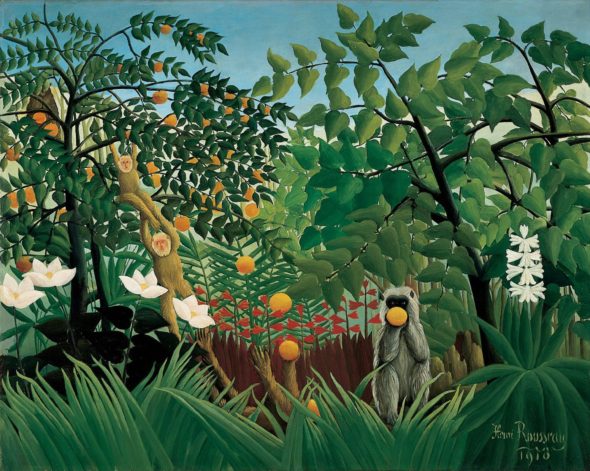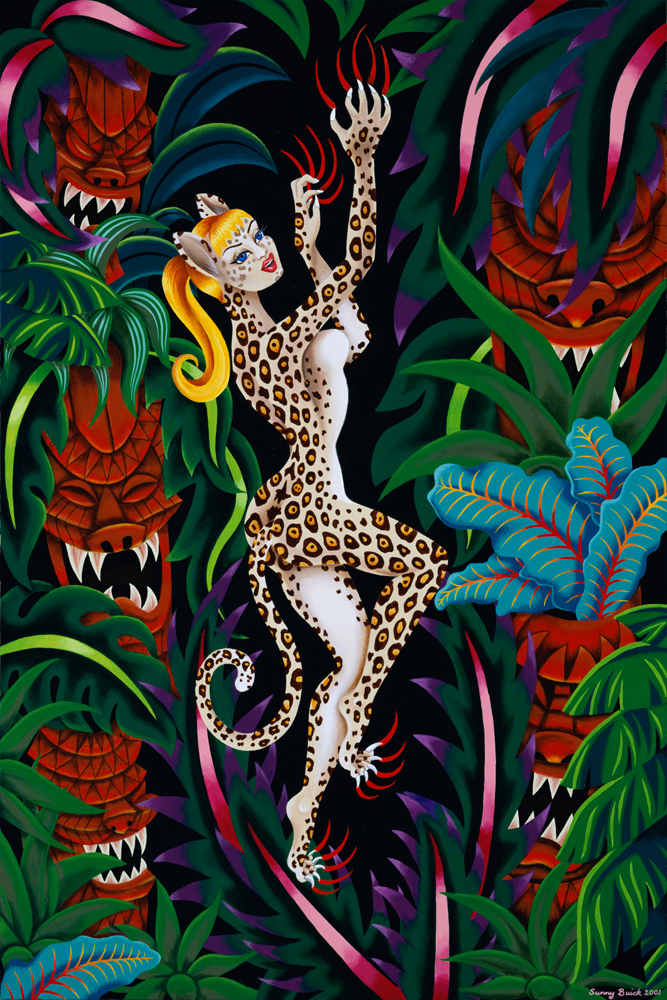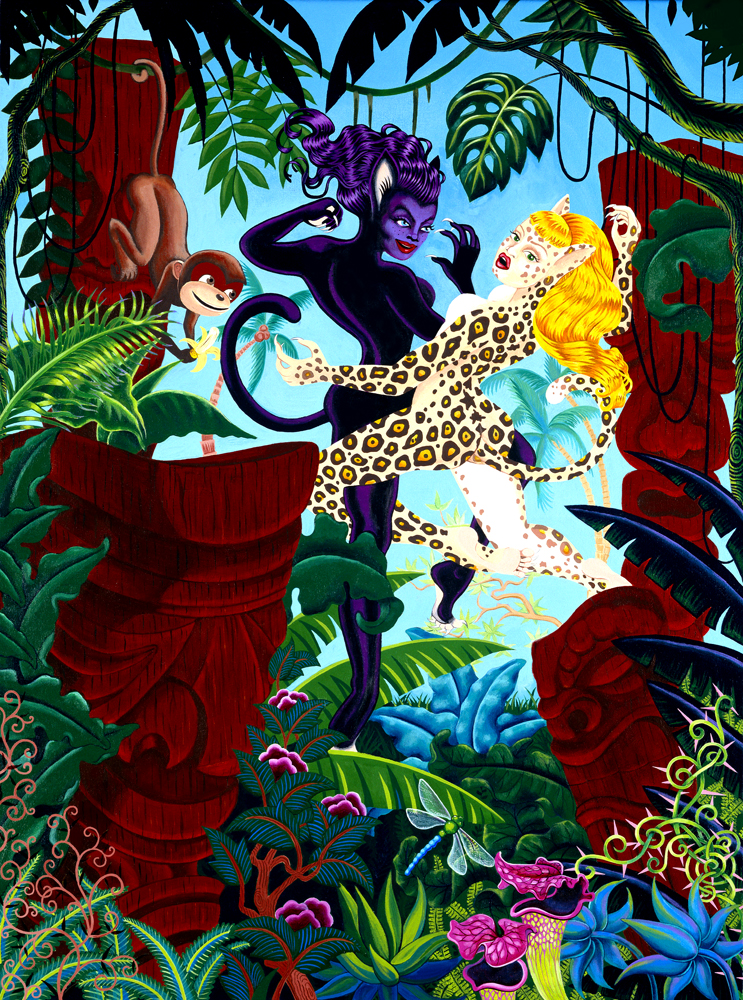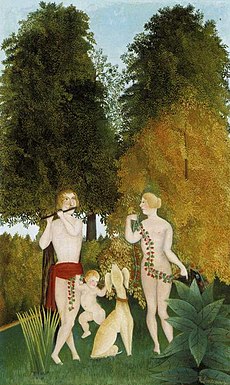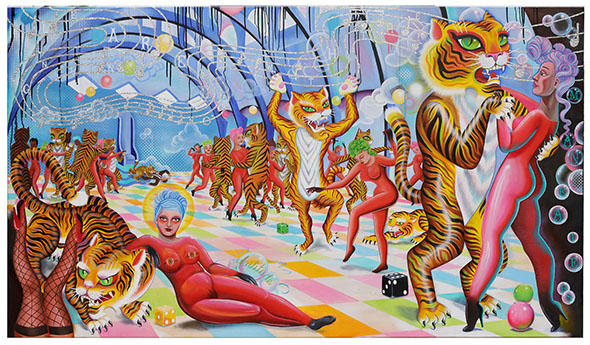Henri Rousseau
I am the spiritual grand-daughter of Henri Rousseau. Henri Rousseau was a painter living in the last half of the 19th century, naïve, perhaps delusional and yet powerful, compelling, dynamic, forceful and therefore thoroughly modern. He was made legend by all the newspapers and critics that mocked his work unmercifully each year that he participated in the Paris salon. One critic said that Henri Rousseau « paint(s) with his feet, eyes closed ». His was so different from the popular academic style of painting of the era.
Rousseau was loved by the surrealists for his authenticity and genius. His childlike ways and technique inspired empathy and pity, and yet many recognised that this was the way of the future of art. A banquette was held in his honor, by Pablo Picasso at the Bateau Lavoir, a famous art studio building in Paris.
Naive
Here is the definiton of Naive from the Oxford dictionary:
« of or denoting art produced in a style which deliberately rejects sophisticated artistic techniques and has a bold directness resembling a child’s work, typically in bright colours with little or no perspective. »
I don’t know if Henri Rousseau « deliberately rejected sophisticated artistic techniques » or if he was just doing the best he could as he knew how. In any case his style of art was considered naive.
I am the spiritual grand-daughter of Henri Rousseau. My art style is considered naive. I had no formal art education, I use pure colors straight out of the tube.
Bad Art
From the essay «Bad Art» by Quentin Bell: «take the work of almost any three-year-old child and compare it with the productions of an adolescent. The picture by the adolescent will almost certainly be more workmanlike, more intelligent, and, in certain respects, more profound than that of the child, but it will also have a quality of badness, of insincerity, which is completely absent from the first drawings that we make. The badness of the adolescent’s drawing arises from what we call self-consciousness, but which is in fact consciousness of others, not necessarily an awareness of the teacher so much as an awareness of society, of the qualities society deems beautiful. The situation of Gustave Dore or of the adolescent is that he is forced by his perception of social values to modify that frankly unconscious approach which belongs to those who are untroubled by social exigencies — the genius and the child. He is the victim of a dual standard of excellence which leads him, almost inevitably, to a compromise or to a capitulation which necessarily vitiates his sentiments.»
From what I can understand the child artist is authentic and sincere and the genius is not self-conscious.
«The emotional insincerity that makes Gustave Dore’s work so deplorable arises from an enslavement to the standards of his age. Van Gough was liberated from this because the intensity of his vision was such that he could rise above it. The twelfth century artist required so such liberation because he could accept his age without inward questioning, for him there was no conflict hence no insincerity. »
« Bad art, if this analysis be correct, arises from a rather sophisticated state of mind. In order to be insincere the artist must have some sort of choice and his choice must lie between two kinds of excellence, such as will occur only in certain conditions. We need not and should not imagine the bad artist deliberately setting out to please his public. We need not even think of him saying to himself «that looks attractive, that will please the critics». The damnable thing about bad art is that the insincerity that lies at its roots is not perceived by the artist himself.»
Delusional?
Not only was Rousseau’s style simple/naive, but it seems that his belief in his own greatness was delusional (at the time, because we now can recognise his value). He made enormous paintings. He wanted to be noticed, accepted. He said to Picasso, we “are the two most important artists of the age – you in the Egyptian style, and I in the modern one.”
I am the spiritual grand-daughter of Henri Rousseau. I too am completely delusional about my talent and my place in the art world.
Exageration and Mythic Voyages
Rousseau said that he had traveled to Mexico, but the only he place he visited was his imagination, after walks through Jardin de Plantes in Paris.
Rousseau got in trouble for fraud, his paintings were used to prove his naïveté during his trial. He sent notes to the judge from jail begging for his understanding.
Fabricator of Facts, Rousseau once accepted a prize, the Silver medal of the City of Paris that was meant for a colleague with the same name.
Comparing my Work to Rousseau
I am the spiritual grand-daughter of Henri Rousseau. Although you might think otherwise, I never used the paintings of Henri Rousseau as reference. In fact I didn’t know much about him until I saw an exhibition in Paris at the Musée D’Orsay in 2016. The exposition was called « Archaic Innocence ». I was amazed by his technique, the size of the paintings, (you enter into the field of his vision), the beauty and their relevance today.
As an artist, you should be able to describe your work in less than 2 minutes. You never know who you’re going to run into. Here’s my elevator pitch which puts me in line with Rousseau’s heritage:
By mining popular culture and images of the past for archetypes I show this period in history and my place in it today. Making artifacts that will be left behind for future archeologists. I make eye-candy: visual pleasure that apparently has no real nutritional value other than as colorful contradictory imagery yet is a shrewd commentary on our over exposed visual landscape today.
I make art that is a non-verbal expression of my hidden feelings, attitudes and beliefs. Creating an alternative universe by visualizing it courageous anew. Rejecting what I don’t like, looking for the new meanings that come about when I put together two seemingly unrelated motifs. Always searching for the alchemic reaction that comes from adding seperate ingredients together. Trying all the possibilities to reach the golden goal. Tearing things apart and putting them back together. Purifying everything in the furnace of my heart and art.
I’m a painter, performance and video artist. I want to make installations that are immersive. What does my art look like? Imagine if Henri Rousseau lived today and was obsessed by pulp fiction magazine covers from the 1950’s.
The Surrealists
« With its incredible attention to detail, vibrant palette, and absurdist combination of imagery, The Dream (below) reveals why Rousseau’s art was so admired by the Surrealists.» Andre Breton also said “It is with Rousseau that we can speak for the first time of Magic Realism.”
Alfred Jarry author of Ubu roi (1896), the father of pataphysique, wrote about Henri Rousseau’s painting La Guerre twice. He called it, « a raw and unvarnished expression ».
Pataphysics is the science of imaginary solutions, which symbolically attributes the properties of objects, described by their virtuality, to their origins. “The virtual or imaginary nature of things as glimpsed by the heightened vision of poetry or science or love can be seized and lived as real”.
Jarry seems to be the right person to validate the talent of H. Rousseau. That said and the party is his honor held by Picasso, were seemingly enough to seal his place in art history. Or was it his fame from being mocked so often by the press, that made his name so renowned ? And the fabricated self-created mythology, that contributed to the mystique surrounding him?
I have a deep appreciation for Henri Rousseau’s unique style and the complex reception he received during his time. My own artistic approach, drawing inspiration from various sources and aiming to create fantasy environments (maybe delusionally) is similar to his in many ways. Exploring connections between seemingly unrelated motifs and seeking that alchemic reaction in my work, in my dedicated pursuit of creativity. I am the spiritual grand-daughter of Henri Rousseau.
Both Henri Rousseau’s artistry and my own painting reflect an unselfconscious approach that delves into primitive techniques, featuring a genuine desire to leave a mark in art history. Just as Rousseau yearned for recognition, I too strive to capture the essence of bold glory and hidden dreams within my creations, and projects. While Rousseau’s dreamscapes painted vibrant jungles as a form of fantasy, in my work, although inspired by the past, I would like to fabricate new realities through immersive installations.
Here is a quote from my manifesto:
« My style, my ideas are a little Naïve, OK, but that’s also the surface. I’m still that only child who found a little reassurance in a world of her own fantasies.
Making art to me is expressing how I feel about the world, my life, my experiences, wanting to create another world even if it’s just a fantasy. Some of that fantasy is based on an obsession for the past. Creating an imaginary past to restore a sense of belonging. »
Today I try to create an imaginary future for the very same reason.
More from the essay Bad Art by Quentin Bell: « the typical life history of every artistic movement of the past one hundred years has consisted of a struggle against hostility and indifference, the good artist has fought against the popular conception of beauty, the bad artist has accepted it at once or after a brief struggle. There have been two measures of excellence and, as a necessary result, a struggle in which the artist must be continually driven to a compromise, to an insincere bargain which results in falsity of sentiment, in bad art. The typical aesthetic history of the child, that is to say, the suppression of pure emotion untroubled by any conscious pursuit of beauty and its replacement by an attitude of social deference allows us to suppose that, in modern society this conflict, and the almost inevitable victory of social taste, makes bad art a normal, if not universal, phenomenon. »
The concept of “bad art,” as described by Quentin Bell, highlights the struggle artists face against societal standards, leading to compromises, diluting the purity of artistic sentiment. Rousseau’s work, or a child’s art are unburdened by such conflicts, and stood out, much as I hope my own pursuit of unapologetic creativity, will not conform and will stand the test of time.
I am the spiritual grand-daughter of Henri Rousseau.
In essence, both Rousseau and I share a commitment to unbridled expression, whether through the vibrant jungles on canvas or the fabrication of new realities in fantastic, unsophisticated environments. It’s a testament to a form of artistic freedom that transcends fashions, echoing the sentiment expressed by Bell regarding the struggle artists face in maintaining authenticity amid pressure of the market.


